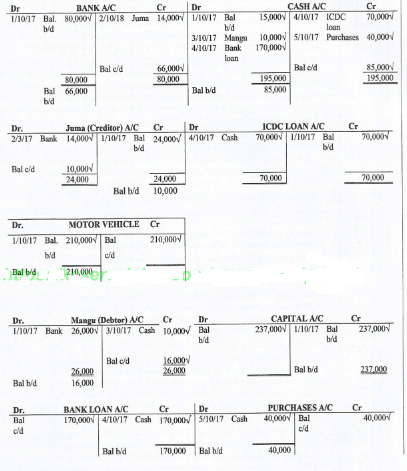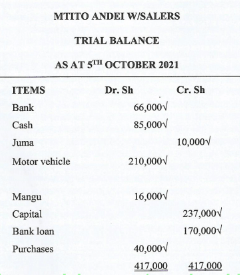QUESTIONS
-
- Explain five circumstances under which a bank may dishonour a cheque. (10 marks)
- Explain five factors that may lead to an increase in the level of National Income of a country. (10 marks)
-
- Explain five factors that may lead to dissolution of a co-operative society. (10 marks)
- Explain five features of underdeveloped countries. (10 marks)
-
- The following balances were extracted from the books of Mtito Andei Wholesalers on 1st October 2021:
The following transactions took place in the first week of the month:Details Ksh Bank 80,000 Cash 15,000 Juma (creditor) 24,000 ICDC loan 70,000 Motor vehicle 210,000 Stock 45,000 Mangu (debtor) 26,000 Capital 237,000
October 2nd Withdrew Ksh 14,000 from the bank to pay Juma.
October 3rd Mangu paid his debt of Ksh 10,000 cash.
October 4th Took a loan from bank worth Ksh 170,000 cash of which Ksh 70,000 was used to clear outstanding ICDC loan.
October 5th Purchased goods worth Ksh 40,000 in cash.
Required- Record the above transactions into their relevant ledger accounts and balance them off. (8 marks)
- Extract a trial balance as at 5th October 2021. (4 marks)
- Explain four elements of a good transport system. (8 marks).
- The following balances were extracted from the books of Mtito Andei Wholesalers on 1st October 2021:
-
- Explain five ways in which employees may contribute to the success of a business. (10 marks)
- Explain five roles of the World Bank in promoting international trade. (10 marks)
-
- Explain five limitations of mobile phones in communication. (10 marks)
- Use the diagram given below to answer the questions that follow.
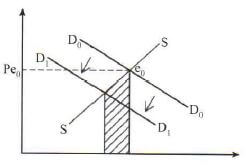
- Explain four effects of the shift in demand curve from D, to D. (8 marks)
- State what is represented by the shaded area. (2 marks)
-
- The following Trial Balance was extracted from the ledgers of Ushindi Traders on November 2021.
Stock on 30th November 2021 was valued at Ksh 8,500.Ushindi Traders
Trial Balance as at 30th November 2021Details Dr Cr Ksh Ksh Capital 58,300 Sales 200,000 Purchases 111,000 Salaries 13,300 Rent Income 40,000 Stock 1/12/2020 12,500 Insurance 10,500 Telephone 9,500 Advertising 14,000 Premises 100,000 Furniture 16,000 Debtors 33,500 Creditors 53,000 Cash in hand 18,400 Cash at bank 12,600 351,300 351,300
Prepare the business Trading, Profit & Loss Account for the year ended 30th November and a Balance Sheet as at that date. (12 marks) - Explain four reasons that may make Government departments adopt open office layout. (8 marks)
- The following Trial Balance was extracted from the ledgers of Ushindi Traders on November 2021.
MARKING SCHEME
-
- Circumstances under which a bank may dishonour a cheque:
- If the cheque is post-dated. It is presented to the bank/drawee before maturity date.
- In case of insufficient funds in the account of the drawer/t bank may not be willing to give an overdraft.
- When the amount in words differs from the amount in figures hen decision on which figure to pay arises
- If the cheque is defaced/torn/dirty making its content illegible/doubtful.
- If there are alterations/changes on the cheque which are not countersigned.
- If the signature on the cheque differs from the specimen signa ure held by the bank thus its authenticity is in doubt.
- When the cheque is stale/outdated. It is presented six months after the date of issue.
- If the account holder is dead and the bank is aware of the fact/notified
- If the drawer instructs the bank not to pay a particular cheque based on reason known to him/her.
- If the drawer becomes bankrupt/insane thereby losing contractual capacity to transact and the bank is aware
- When a customer is presenting a crossed cheque to be paid across the counter instead of depositing in the account
- If the drawer's account is closed/not operational hence cannot be used
- If the cheque has omissions, thus making it invalid.
- If the cheque is forged and the bank is able to confirm/detect (Any 5 x 2=10 marks)
- Factors that may lead to an increase in the level of National income in a country includes:
- Political stability. Encourages investors/investment/increased production activities thus high levels of national income.
- Use of appropriate/modem/better technology to produce high quality and quantity goods/services which increase output.
- When citizens have positive attitude towards work productivity is enhanced.
- Increased foreign investments may bring more injections in the domestic economy/increased production thereby increasing the level of national income.
- Existence/availability of established entrepreneurial culture promotes effective exploitation of available resource endowment/ enhance productivity.
- Availability of adequate/sufficient capital will enhance produce on of high quality goods/services which attract better returns.
- Discovery of natural resource to be exploited for production.
- Good governance/accountability/transparency leading to better use of resources/efficient production attract investment
- Reduced subsistence sector/increase market sector where most of what is produced is sold to generate income.
- Favorable/improved terms of trade leading to increased earning.
- Enhanced security that encourages investment
- Improved infrastructure that leads to more efficient production of goods and services
- Increase in skilled/trained labour/manpower leading to increased/efficien quality production.
- Better/maximum/optimum/increase use of existing/idle resources that leads to increased production of goods/services.
- Favorable government policy that can create a conducive environment for production/investment
(Any 5 x 2=10 marks)
- Circumstances under which a bank may dishonour a cheque:
-
- Factors that may lead to dissolution of Co-operative Societies includes:
- Persistent/continuous disagreement among the members to an extent that they cannot be reconciled.
- Mutual agreement among the members to dissolve hence left with no option but to wind up/one member request for dissolution and his wish granted
- Insolvency/bankruptcy. When the Co-operative is unable to meet its financial obligation.
- A court order forcing dissolution of the co-operative out of a complaint/change of law.
- The Minister/commissioner of Co-operatives/government may order for its dissolution in the interest of the public/its members for engaging in illegal activities
- Mass withdrawal of members leaving less than the minimum required by law/ less than ten.
- Change in law/government policy that makes activities of cooperative illegal
- If it has achieved its intended objective(s) for which it was formed hence makes its continued existence unnecessary.
(Any 5 x 2 =10 marks)
- Features of under-developed countries includes:
- Overdependence/overreliance on foreign aid to fund/finance development in their economies/leading to political blackmail vulnerability
- Underutilization/under-exploitation of natural resources due to inadequate/ ttps://inappropriate technology/skills/knowledgebership-join/
- High rates of unemployment due to low levels of industrial development/low level of production.
- Inadequate healthcare/malnutrition leading to low levels of life expectancy/ high mortality.
- Unfavourable balance of payment due to low/subsistence productivity/high rates of importation of producer goods/poor terms of trade/low value of exports
- Underdeveloped/poor infrastructure due to limited capital which hinders mobility of goods/services.
- Overdependency on subsistence sector due to inadequate skilled labour/capital necessary for production leading to low output/income.
- High population growth/overpopulation/high birth rate where the growth rate is higher than the national output/resources of the country
- High levels of poverty/low per capita income where a large proportion of citizens live below the poverty line/survive on less than a dollar a day.
- Low level of technology due to lack of capital which leads to low quality/ quantity of goods/services
- Low level of savings due to low per capita income/leading to low investment
- Poor governance due to corruption/embezzlement/misappropriation/lack of accountability/transparency/mismanagement of resources.
- Political instability/insecurity which hinders investments/production
- Poor social amenities leading to poor services
- High level of illiteracy due to ignorance/limited exposure
- Factors that may lead to dissolution of Co-operative Societies includes:
-
-
-
- Unit of carriage
- Any vessel/means/ship/train/motor vehicle used to transport goods and services from one place to the other,
- Way
- Route/path/road/air/water/pipeline followed by the vessel from one place to the next
- Method of propulsion/motive
- Refers to the driving force/source of power/wind/solar/unit engine/human power jthat makes the unit of carriage to move.
- Terminal
- Loading/offloading/starting/ending places for the vessels.
- Safety to prevent damage/injury to goods/people.
- Security to prevent theft/loss of goods/services.
- Affordability/economical to reduce on costs/expenses of moving goods/services/people.
- Availability/accessibility can easily be found/reached when needed.
- Flexibility - ability to adjust according to needs of user.
- Reliability - ability to adjust according to needs of the user.
- Unit of carriage
-
-
- Ways in which employees may contribute to the success of a business include:
- Skilled/qualified employees will produce/offer quality goods /services.
- Employees who have skills that match their job requirements lead to minimum wastage.
- Proper time management will enable the business to offer time y delivery of services/goods.
- Employees who treat customers well will improve the image of the business
- Disciplined employees do not need a lot of supervision since they are responsible/lead to reduced operational cost.
- By offering their labour for continuity of production
- Quality/good/proper decisions made in the interest of the business.
- Pass positive feedback from customers for improvement of the business.
- Innovative/creative employees leading to better/new goods/services.
- Committed/hardworking employees leading to increased productivity.
- Loyalty/positive attitude to protect the interest of the business
- Teamwork which leads to harmony/synergy/cooperation
- Goal oriented employees leading to meeting of targets/objectives of the business
- Self driven/self motivated employees that perform tasks with minimal/no supervision without coercion.
- Practicing integrity/ethical behavior since they are able to do the right thing even when they are not observed/supervised.(Any 5 x 2 = 10 marks)
- Roles of World Bank in promoting international trade includes:
- Providing medium/long term loans used in financing balance of payment deficit/budgetary support.
- Giving financial aid to be used in producing goods/services fo the world market/project development.
- Set up international standards that must be met to access world market so as to create fairness/fair competition
- Advice member countries on the best suitable projects to invest in/to diversify their exports on economic policies.
- Act as a guarantor to member countries who want to obtain bilateral loans for development/Production of exports.
- Encourages technology transfer among member states to enable them exploit natural resources in order to create wealth.
- Stabilizes/controls the major world currencies/exchange rates to ensure international prices charged for imports and exports remain stable.
- Co-ordinate formation of partnerships/integration to facilitate sharing of knowledge, research findings/expertise for mutual development
- Provision of personnel/manpower/experts to facilitate project implementation/ appraisal/ management/ identification
- Approving/evaluating development plans from member countries for funding. Promotion of good governance to avoid loss/misuse of public funds/resources by fighting corruption/embezzlement of fund
- Encourages economic reforms/structural adjustment that stimulate economic growth/development/productivity
(Any 5 x 2=10 marks)
- Ways in which employees may contribute to the success of a business include:
-
- Limitations of using mobile phones in communication includes:
- Poor network coverage/transmission channel overload may limit/hinders effective communication in some areas
- May not be suitable for the deaf/dumb/hearing impaired/visually impared as that may not be able to receive/relay calls (information) on their own.
- A health hazard to the user as it exposes them to radioactive waves due to prolonged use..
- May be distractive hence result into undesired consequences like waste of working time/disrupt peoples' attention/distract people's attention
- Mobile phone usage may be restricted in some areas/business premises due to security reasons/may be a security threat in churches/banks/meetings
- Expensive/costly to operate since it requires regular top-up of air time/data upload etc.
- Require regular charging thus may go off when needed the most and there is no power.
- Costly/expensive to buy/acquire making it unaffordable to some users.
- May lack confidentiality since information/calls may be tapped/ntercepted/ monitored/hacked
- Prone to theft leading to theft of handset/information/data (Any 5 x 2=10 marks)
-
- Effects of the shift in demand curve from Do to Di include:
- The equilibrium point will shift from Eo to a lower point where the new demand (D1) curve meets the supply curve.
- The equilibrium quantity will fall, moving from Qeo to a lower level at the point where the new demand curve D1 meets the supply curve.
- The equilibrium price will drop from Peo to a lower level where D1 meets the supply curve.
- There will be excess supply as demand falls with supply remaining constant.
- Supply will have to reduce in the long run due to suppressed prices.
- May be wastage/high costs of storage in the short run. (Any 5 x 2=10 marks)
- The shaded area represents excess supplu/surplus in the market. (1 x 2 = 2marks)
- Effects of the shift in demand curve from Do to Di include:
- Limitations of using mobile phones in communication includes:
-
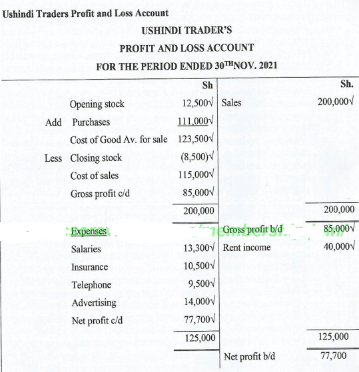
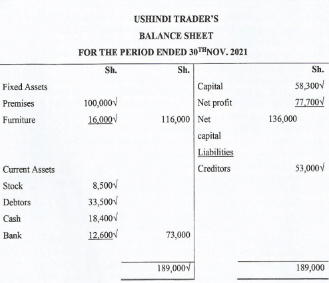
-
- Encourages easy supervision of workers which improves on produtivity as they are aware they are being watched since they are in the same room.
- Low/minimal cost of construction/maintenance due to few partitions
- Easy to locate employees as everybody works in the same room which saves time.
- Reduces corruption/fraud/misuse of resources as employees actions are easily monitored/ does not give room for soliciting for bribes thus promoting accountability/integrity/ethical behaviour.
- Limited office machines/equipment are shared which greatly reduces operation cost/wastage of resources/avoid duplication.
- Discouraging absenteeism/lateness/early departure as workers absence can be easily noticed due to close supervision/ monitoring.
- Encourages team work as employees can consult both formally/informally/share ideas/promote friendship/personal understanding.
- Economy of space/more floor space is available due to few/no partition thus can accomodate more staff.
- Fast/easy communications between workers since there are no physical barriers between them/are found in the same room.
- Faster flow of work due to reduced movements/working mclose to one another.
- Minimizes/ discourages laziness/idleness/laxity since workers can see/ check/monitor each other.
Join our whatsapp group for latest updates
Tap Here to Download for 50/-
Get on WhatsApp for 50/-
Download BUSINESS STUDIES Paper 2 Questions and Answers - KCSE 2022 Past Papers.
Tap Here to Download for 50/-
Get on WhatsApp for 50/-
Why download?
- ✔ To read offline at any time.
- ✔ To Print at your convenience
- ✔ Share Easily with Friends / Students

